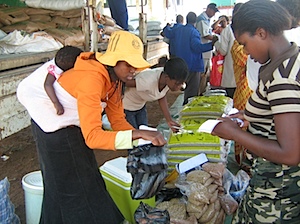- “Food is the most cost-effective intervention.”
- Peru promotes potatoes.
- The Importance of Biodiversity to Medicine. Anyone got access? Any mention of nutrition?
- EU Says bees should rest. Problem solved.
- Extreme beer. All problems solved.
- Eat local? I don’t think so.
- Itchy Italian gourmands gutted over climate change-caused truffle troubles.
- Mulberry trees pay the price for immodesty.
- While fig trees planted by Jesuits survive. It’s a funny old world. Fruit tree trifecta in play.
- And it comes in! Today’s saving-the-frigging-English-apple story comes to you from The Guardian. Enough already, the English apple is going to be fine.
Input fairs: the view from the ground
One of the FAO’s preferred responses to food emergencies is the Input Trade Fair. Farmers receive a voucher, which they can exchange for seeds and other inputs that they need for a better harvest. In 2007, for example, 20,000 government-selected families in central and eastern Swaziland received vouchers that they could spend at one of 25 Input Trade Fairs. Earlier this year, FAO described these fairs as “winners”. But as the 2008 planting season gets under way, the news from Mbabane is not good.
 A report carried by IPS says that Swazi Input Fairs [are] Falling Short. Far fewer farmers have received vouchers this season. In the wake of rising prices the vouchers are not enough to purchase all the inputs needed. More vendors have entered the market, cutting down on sales for existing vendors. But most worrying of all, according to the report most of the subsistence farmers who have benefited from the scheme are no nearer being able to stand on their own feet than they were before the scheme started. Some, it is said, have no real interest in farming. They are just hungry, and wash the pesticidal dressings off the seeds before cooking and eating them. Many farmers refuse to switch away from maize, which needs far more water than crops such as sorghum.
A report carried by IPS says that Swazi Input Fairs [are] Falling Short. Far fewer farmers have received vouchers this season. In the wake of rising prices the vouchers are not enough to purchase all the inputs needed. More vendors have entered the market, cutting down on sales for existing vendors. But most worrying of all, according to the report most of the subsistence farmers who have benefited from the scheme are no nearer being able to stand on their own feet than they were before the scheme started. Some, it is said, have no real interest in farming. They are just hungry, and wash the pesticidal dressings off the seeds before cooking and eating them. Many farmers refuse to switch away from maize, which needs far more water than crops such as sorghum.
While an on-the-spot report such as this one offers some insights, it does not indicate how Swaziland’s drought-stricken farmers could best tackle their problems. Maybe they need more extension help, to show them how to make better use of their inputs. Maybe they need radical changes in their methods. I was at a meeting in London on Wednesday where I saw a very short video called Greening the Desert. Geoff Lawton, of the Permaculture Research Institute of Australia, explained in tantalizing snippets how he had transformed a barren patch of Jordan into a flourishing orchard. No, I have not seen peer-reviewed results. But it seems worth trying elsewhere, and Swaziland could be a good place to do so.
Agrobiodiversity tourism alive and well in South of France
I’ve been in Montpellier for the past few days attending what is actually quite an interesting conference, which is just as well because we’re out in a pretty uninteresting suburb. We did get a day off on Saturday, but otherwise we haven’t had much free time. A pity, because perusing the little pamphlets describing different local tourist attractions that one finds scattered around the hotel reveals at least three with interesting agricultural biodiversity angles.
One is a boat tour around the Isles de Stel in the Camargue: salt works, horses, bulls, rice fields, local food, the lot. Plus it starts from the fascinating medieval town of Aigues-Mortes. ((Which was the destination of our field trip on Saturday, and the subject of my autostitched photo. Well worth a visit.))

Or you can visit a buffalo reserve near Sainte-Eulalie. This seems to refer to the wisent, saved from extinction by captive breeding in Poland.
And, finally, there’s La Bambouseraie, near Anduze. It’s a botanic garden, resource centre and nursery dedicated to bamboos that was established in 1856 by Eugène Mazel.
Mazel had made a fortune in trading with spices he directly imported from Asia. This activity allowed him to have plants, practically unknown in Europe at that time, sent to him from these distant countries.
Too bad I’m stuck in this hotel. Although, what with the Air France strike and all, I might get the chance for some sightseeing after all.
Nibbles: Sturgeon, UK, Goats, Bees
- North America’s largest freshwater fish saved from extinction.
- 10 years ago, Britain’s National Trust turned “its biggest managed farm into a gigantic experiment as an antidote to intensive farming” in Snowdonia.
- The origin of the goat investigated.
- Tracking bees.
Nibbles: Coffea, Tequila, Livestock wild relatives, Rice wine, Vit. D, Statistics
- Wild coffee studied; report from Madagascar.
- Adding value to tequila. Lots of value.
- Vietnamese farmers go wild.
- Vietnamese farmers get drunk.
- All about Vitamin D.
- “…cranberries are the neglected stepchild of the season.”
- What does that make the turkey?
- Gates Foundation moves into space. Via.